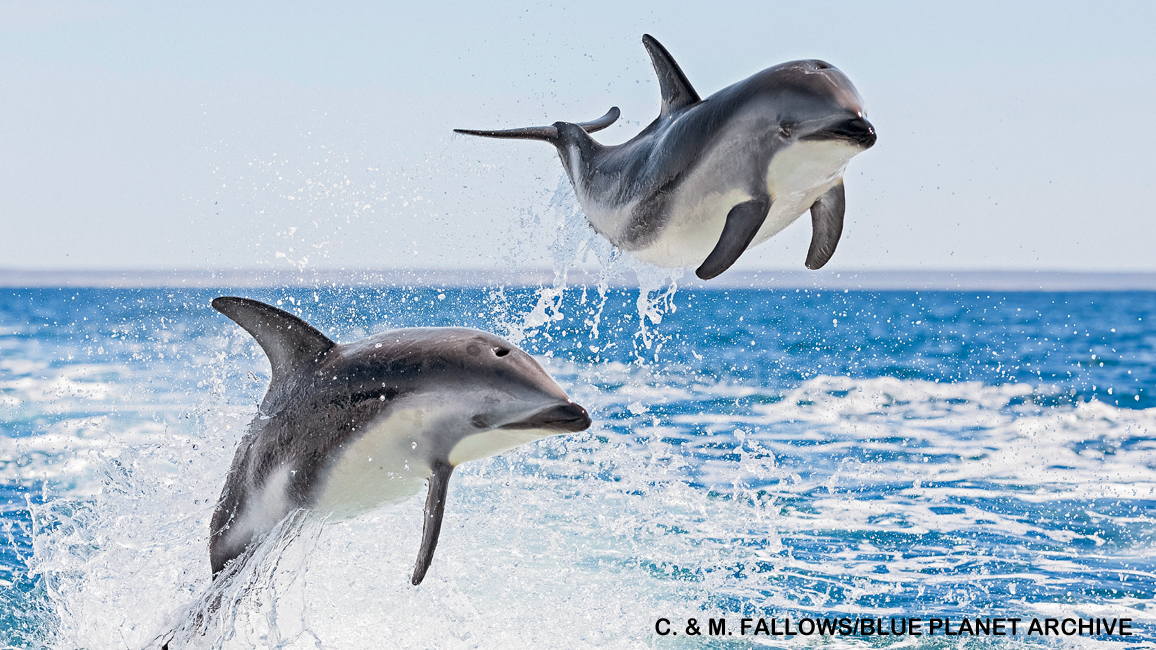
Diving with Dolphins
By Kathy KrankingMeet some leapin’ dolphin cousins!

You probably know the most famous kind of dolphin, the common bottlenose dolphin. It’s the one peeking into the page above. But did you know that the dolphin family has more than 30 different members? The smallest kind of dolphin is about as long as you are tall. And the biggest is almost as long as a school bus. It’s the orca, or killer whale.
The leapin’ dolphins here are dusky dolphins. Dolphins are known for their acrobatics, and duskies are some of the most acrobatic dolphins of all. Many dolphin species leap out of the water as they swim. But duskies can do leaps, somersaults, and rolls before splashing back into the water!

DOLPHIN BASICS
Dolphins are found from coasts to the open ocean, in warm waters as well as colder ones. A few even live in rivers or lakes. Though dolphins may look like fish, they’re mammals—just as you are! So, dolphins and people have lots of things in common, including breathing air with lungs, being warm-blooded, and nursing their young.
BIG GULPERS
When it comes to eating, fish is a favorite of most kinds of dolphins. Depending on the species, dolphins may also chow down on squids, octopuses, jellyfishes, and crunchy foods such as shrimps and crabs. Orcas and other large dolphins eat even bigger prey, including seals or sea lions. Cone-shaped teeth help dolphins grab their food, which they often gulp down whole.
SEEING WITH SOUND
Dolphins have a cool trick for locating things around them, including prey. They use echoes. This is called echolocation. (See diagram.) First, a dolphin makes some clicking sounds by passing air between lip-like parts in its head called phonic lips. The sounds pass through another part of the dolphin’s head, called the melon. The melon helps aim the sounds straight ahead (red lines). If the sounds hit something in front of the dolphin, they bounce back as echoes (blue lines). When the sounds reach the dolphin, they travel through a fat-filled part of its jaw to its ears, which are inside its head.
By listening to the sounds, the dolphin can tell the size and shape of the object, as well as how far away it is and which way it’s going.

PLAYTIME
Just as you do, dolphins of all ages love to have fun. They spend lots of time chasing each other, jumping, flipping, and playing in other ways. And they can make a toy out of almost anything, including seaweed, coral, bubbles—even trash they find in the water.
Groups of dolphins often invent their own games and teach them to their young. If you think that makes dolphins sound smart, you’re right! Some scientists believe they may be Earth’s most intelligent creatures, after humans. Dolphins are able to learn many different behaviors, and they can solve puzzles that scientists give them. Some wild dolphins have even learned to use “tools.” When they search the bottom for food, for example, they hold sponges over their beaks. This may protect them from sharp shells or rocks. Dolphins are smarties, for sure!
HAPPY TOGETHER
These mammals are social animals. That means they like to hang out with each other. A group of dolphins usually has about 5 to 20 members. But sometimes many groups join each other for a short time, making a huge one that can have hundreds
of dolphins.
Dolphins are very chatty. They “talk” to each other with sounds such as chirps, clicks, and whistles. Each dolphin has its own personal whistle that’s different from other dolphins’ whistles. So, if a mom and her baby ever get separated, they can find each other by calling with these special whistles.
Now you know the truth: Whether they’re flipping, playing, chatting, or spinning, dolphins are amazing.

















